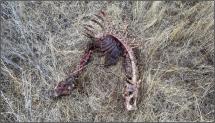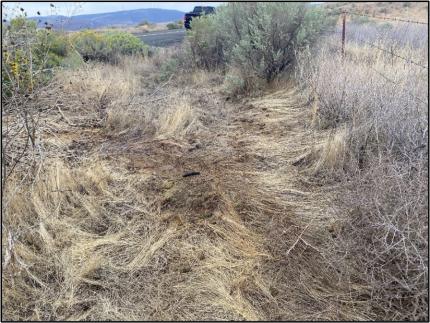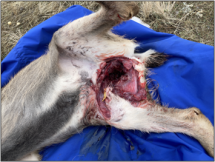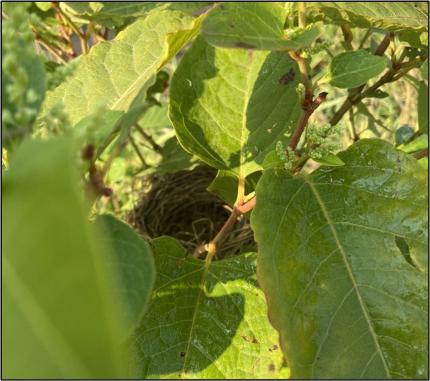Managing Wildlife Populations
Fish Removal: Biologists Wickhem and Bergh spent two days removing non-native fish from a lake inhabited by state-endangered northwestern pond turtles. The fish compete with the turtles for food and the larger fish eat hatchling turtles. The water in the lake was extremely low which caused the fish to be concentrated in small pools. The mud made it difficult to get around, but many five-gallon buckets of fish were removed.



Columbian White-tailed Deer Population Monitoring: Biologists Holman and Stephens along with Wildlife Area Assistant Manager Risley joined U. S. Fish and Wildlife Service Biologist Kruenegel to set cameras in habitat occupied by Columbian white-tailed deer in Cowlitz County. The camera sets are designed to generate data to determine the current relative abundance of Columbian white-tailed deer verses black-tailed deer in specific areas where the species are sympatric (occupying the same habitat and location). The photographs will be collected in the coming months and used to complement aerial surveys for the white-tails that will happen next February.

Columbian White-tailed Deer Necropsy: Biologists Holman and Stephens joined U. S. Fish and Wildlife Service Biologist Kruenegel and Assistant Refuge Manager Bonello to necropsy a Columbian white-tailed deer that was euthanized in Wahkiakum County. The deer was acting abnormally and very emaciated. The necropsy revealed worn teeth and further demonstrated the deer’s poor nutritional state (zero fat over the heart or kidney). No specific signs of disease were noted, and lung, liver and heart tissue all appeared normal. Evaluation of stomach contents failed to reveal atypical foods. Samples for Chronic Wasting Disease, ageing, and genetic testing were collected and retained by U. S. Fish and Wildlife Service.
Columbia Gorge Pika Surveys: Biologist Wickhem completed four surveys for American pikas in the Columbia River Gorge this September. Wickhem was assisting with a long-term monitoring project run by the U.S. Geological Survey that tracks pika occupancy at many sites throughout the Gorge. This season, the project was focused on “edge sites” or areas that are considered either at the edges of the pikas' range in the area, or the edges of what is considered the Gorge habitat verses more traditional mountainous/alpine pika habitat. Throughout North America, American pikas are usually only found in higher elevations, but the Columbia River Gorge is the only place where American pikas occur at near sea level. Collared pikas, that live in northern Canada and Alaska, can live at sea level but are a different species. On these surveys, Wickhem confirmed pikas at three out of the four sites either by hearing calls or by finding fresh hay piles (pika food cache) and latrines.


Klickitat Mule Deer Mortality Investigation: Biologist Wickhem investigated the mortality signal from a collared female mule deer this week. From the map of its recent locations, it appeared the doe had been hit by a car, but when Wickhem arrived it was obvious that she had been aggressively scavenged by coyotes for several days. It was impossible to tell if the coyotes had killed her next to the road, or if she had been hit by a car and found by the coyotes soon after. This deer is part of a four-year study being conducted throughout GMUs 388 and 382 to track the annual movements of female mule deer and locate important migration corridors. Staff members are also attempting to determine cause of death when an animal dies, which has proven to be difficult. In winter 2021, 81 collars were deployed throughout GMUs for this effort. Twenty-two collars were deployed in the winter of 2022 and 23 were deployed in winter 2023. Most of the redeployments replaced study deer that died over the first two years of the study. We are nearing the end of the study so this collar will not be redeployed for this project.


Providing Conflict Prevention and Education
District 9 Calf Depredation: Wildlife Conflict Specialist Jacobsen followed up on a report from the Klickitat County Sheriff’s Office of a cougar depredation on a domestic calf. The landowner had observed the cougar feeding on the calf carcass and called the Sheriff’s Office, who came out and located and killed the cougar with the use of hounds. Jacobsen arrived and confirmed the depredation as a cougar depredation. He will work with the livestock producer on filing a livestock loss damage claim if he is interested.

Injured Deer: Wildlife Conflict Specialist Jacobsen was contacted by a homeowner who was concerned about a deer in his yard. The deer had an injury to its side and the homeowner believed the deer needed to be euthanized. After examining photos of the deer, Jacobsen advised the homeowner that the deer would likely survive and that it should be left alone. Jacobsen also reviewed with the homeowner multiple reasons why supplemental feeding of deer is actually harmful to the deer. The homeowner agreed to stop feeding the deer.

Second Injured Deer: Region 5 Wildlife Program staff members were contacted by a homeowner regarding a deer with netting tangled around its antlers. Both District Biologist Bergh and Wildlife Conflict Specialist Jacobsen attempted to contact the reporting party multiple times. It is unknown what became of the entangled deer.

Another Injured Deer: Wildlife Conflict Specialist Jacobsen spoke with a landowner who reported a sick or injured deer laying in her yard. Jacobsen reviewed the photos and agreed that the deer was in poor condition and likely needed to be euthanized. Sargent John authorized the landowner to euthanize the deer.

Fourth Injured Deer: Washington Department of Fish and Wildlife Dispatch contacted Wildlife Conflict Specialist Jacobsen regarding a deer that had been caught in a fence in Goldendale and that needed to be euthanized. Jacobsen adjusted his plans and met Goldendale Police Department staff members on scene. The deer was no longer caught in the fence but had incurred severe injuries from the incident and needed to be euthanized. Due to the deer’s location in a residential area, Goldendale Police Department staff members determined that it was not safe to discharge a firearm in the area and requested Washington State Department of Fish and Wildlife assistance. Jacobsen successfully immobilized the deer with a dart gun and was able to transport the immobilized deer to a safer location to euthanize it. It is not uncommon for deer (especially fawns) to get caught in fences, particularly around residential neighborhoods. Homeowners should seek to install wildlife-friendly fencing (PDF)around yards to prevent deer from getting caught on fences as they try to cross.


Camas Bear Sightings: Wildlife Conflict Specialist Jacobsen fielded multiple calls regarding a bear wandering around the Lacamas Lake, Camas area. It appears the bear made a few wrong turns and spent several days trying to figure out how to leave the urban area.

Elk/Deer Fencing Project Inspections: Wildlife Conflict Specialist Jacobsen completed several fence project inspections for elk/deer proof fencing. Over the past four years, the Washington Legislature has appropriated funding for Washington Department of Fish and Wildlife to enter into cost-share fencing projects with commercial agricultural producers who are experiencing substantial elk and deer damage to crops. So far, Jacobsen has completed 11 cost-share fencing projects totaling almost 5.5 miles of fencing around commercial operations, ranging from vineyards to produce to oat crops. Jacobsen spent time this week mapping out and obtaining quotes for additional fencing projects in District 9.



Sheep Depredation: A landowner contacted the Department of Fish and Wildlife regarding two sheep that went missing and one that he found dead in his pasture. Unfortunately, the landowner burned the sheep carcass the day prior, so it was not available for inspection. Wildlife Conflict Specialist Jacobsen, accompanied by Regional Operations Manager Varley, responded to the sheep farm. After walking the perimeter of the pasture and not finding any signs of the sheep, Jacobsen began exploring the woods and creek bottom across the street. Jacobsen located one of the missing sheep carcasses in the creek bottom. Jacobsen provided advice and hazing materials to the landowner, and strongly encouraged him to begin penning his livestock up at night.


Coordinated Resource Management Planning Meeting: Wildlife Conflict Specialist Jacobsen attended a Coordinated Resource Management Planning meeting with Klickitat County livestock producers and land managers to discuss wolf-livestock range issues.
Conserving Natural Landscapes
Eagle Island Unit: Approximately five weeks were spent this August and September treating Scotch broom and knotweed on the Eagle Island Unit of the Mt. St. Helens Wildlife Area, located in the North Fork of the Lewis River. This island is normally only accessible by boat, but during the month of August, river flows are low enough that staff members can access the island by foot or UTV.
Treating knotweed is generally not very fun. These days are long, the weather is muggy, the bugs are plentiful, and the three gallon backpack sprayers feel excessively heavy at the end of the day. However, at the end of an intense knotweed season, staff members get the satisfaction of watching the knotweed turn crispy and brown. It is even more satisfying kayaking down the river, surveying the shoreline for any knotweed plants that have escaped herbicide treatment. Assistant Manager Risley and Technician Crane made this float in approximately three hours, treating knotweed and purple loosestrife along the way.


Merrill Lake Unit: Just in time for hunting season, Technician Crane and Assistant Manager Risley visited each of the official campsites at the Merrill Lake Unit to replace signs that went missing this summer. Unauthorized campsites were disassembled, and trash was cleaned from every site. Well-worn trails to the falls indicate that recreational use of the unit has been very high this year.


Simcoe Boundary Marking: Biologists Wickhem and Bergh spent two days refreshing the signs marking deer area 5382 Simcoe as well as marking the new property lines at the Simcoe Unit of the Klickitat Wildlife Area. Washington Department of Fish and Wildlife recently acquired two new parcels, one on the south edge of the unit and one on the west edge of the unit. The new parcels are included on the map on WDFW’s Simcoe Unit webpage as well as on the Klickitat County Assessor’s online mapping tool.


Providing Education and Outreach
Mt. St. Helens Wildlife Area: Professors and students from the University of Nottingham’s Mt. St. Helens Field Course visited the Mudflow Unit to collect geographical data at multiple cross-sections of the North Toutle River flood plain. This is the 16th year of data collection that the university has collected in their ongoing study of Mt. St. Helens and the sediment and debris flow since the 1980 eruption. Assistant Regional Wildlife Program Manager Hauswald and Assistant Manager Risley met up with the students and their professors during their lunch break to talk with them about the elk management and conservation work that is done by Department of Fish and Wildlife at the wildlife area.

Vancouver Wildlife League Presentation: Biologist Holman presented on southwest Washington elk management to a group of approximately 20 members of the Vancouver Wildlife League. The presentation featured the history of local elk spanning 1980-2023, Washington State Department of Fish and Wildlife (WDFW) work to better understand the effects of Hoof Disease, WDFW management efforts surrounding Hoof Disease, and population information. Thanks to the Vancouver Wildlife League for their involvement in hunting and fishing related activities and advocacy spanning nearly 100 years in southwest Washington. For more information on the group see their website here: About us (vancouverwildlife.org) Thanks as well to Regional Director Sallee for attending the presentation.